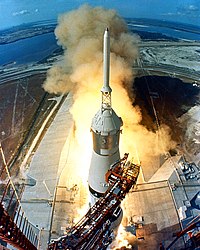Portal:Spaceflight/Selected article/5
The Saturn V (pronounced "Saturn Five") was a multistage liquid-fuel expendable rocket used by NASA for Apollo and Skylab missions between 1967 and 1972. In total NASA launched twelve Saturn V rockets, plus one derived Saturn INT-21, with no loss of payload. It remains the largest and most powerful launch vehicle ever brought to operational status, in terms of height, mass and payload capacity. The Soviet Energia, which flew two test missions in the late 1980s before being cancelled, had slightly more takeoff thrust.
The largest production model of the Saturn family of rockets, the Saturn V was designed under the direction of Wernher von Braun at the Marshall Space Flight Center in Huntsville, Alabama, with Boeing, North American Aviation, Douglas Aircraft Company, and IBM as the lead contractors. The three stages of the Saturn V were developed by various NASA contractors, but following a sequence of mergers and takeovers all of them are now owned by Boeing.

